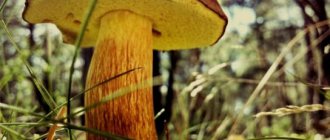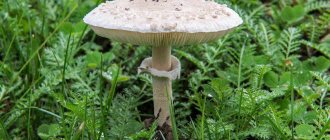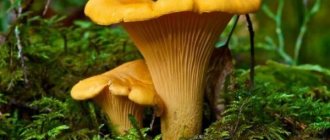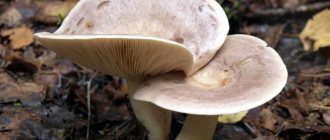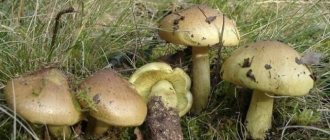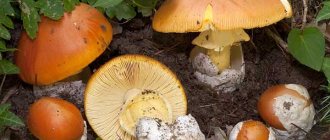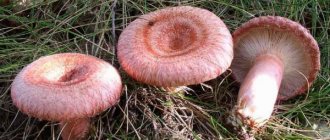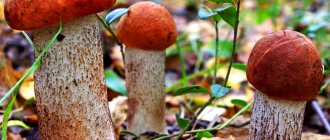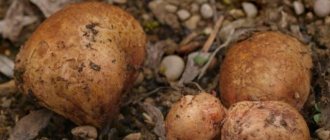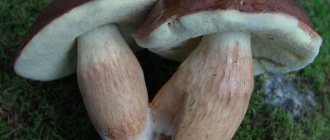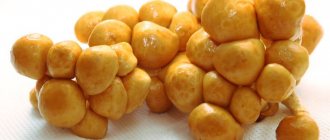Many milkfish are popular among lovers of quiet hunting, for example, saffron milk cap or common milk mushroom. They can be useful or not very healthy; their milky juice will add a special zest to the taste of the mushroom or will repel you with its bitterness. Find out everything about the gray-pink milkweed - is it worth collecting and what can be prepared from it?
Description of lactic mushrooms
Milky mushrooms belong to the lamellar type of mushrooms from the Russula family. Translated from Latin, this name means “milk giver.” These mushrooms are so named because when cut or broken they secrete a milky juice that resembles milk in color and consistency.
They belong to the category of conditionally edible . The radius of the cap of an ordinary milkweed can be from 4 to 11 cm, it shines even in dry sunny weather, and circles are clearly visible on it over the entire surface. Its color changes with the age of the milkweed: young mushrooms are dark gray in color, their caps have a convex shape; older mushrooms are purple or brown, later yellow or rusty, becoming flatter, sometimes even depressed. The surface is very dense, sometimes small pits may appear on it. The edges of the cap can be wavy or curved, often curling inward.
The legs reach 8–10 cm in height, gray or rusty in color, their shape is cylindrical, empty inside, they can be swollen, often covered with mucus, and sticky to the touch. On the lower side, frequent plates are visible; their color is yellow or cream, interspersed with ocher colors.
The pulp is dense, but very brittle . It crumbles easily, since there are practically no fibers in its composition. Its color is white, but near the surface it has a brown tint, and near the stem it has a red tint. The milky juice gives the pulp a characteristic bitterness; when it comes into contact with air, its color becomes yellow with a greenish tint. Its aroma is characteristic, similar to the smell of fresh fish. The spores have the shape of an ellipse, their ornamentation is ridge-shaped or warty. The color of the spore powder is yellow or cream.
Most milkweeds are considered inedible because their juice is too pungent. But it is quite difficult to distinguish between the types of these mushrooms, because they are very similar to each other, sometimes even experienced mushroom pickers confuse the varieties of laticifers, and novice mushroom pickers simply prefer not to put them in the basket.
These mushrooms have no doubles.
Precautionary measures.
As mentioned above, it is very difficult to confuse lacticaria with any other type of toxic mushroom. It is slightly similar in appearance to the silverback, but science does not know any dangerous, poisonous counterparts. Therefore, knowing the main external differences, it is almost impossible to confuse the milkweed with some dangerous mushroom. We must also not forget about standard precautions that do not apply only to this type of mushroom.
There is a golden rule that applies to even the most experienced mushroom pickers: “If you’re not sure, don’t cut!” If you adhere to this rule, the risk of poisoning will decrease tenfold. And of course, we should not forget about the amazing ability of mushrooms to accumulate toxic substances and heavy metals if they grow in an unfavorable, polluted area.
Distribution and fruiting period of laticifers
The first lacticifers appear in the second ten days of July, and the last such mushrooms can be collected in the last ten days of September. But these mushrooms begin to grow actively in rainy, cool weather.
Milkweeds prefer damp places; they usually grow in lowlands in coniferous, mixed or deciduous forests; they are usually collected either under coniferous trees or birch trees. They usually hide in tall grass or among moss. Insects usually do not eat the caps of these mushrooms. Also found along the banks of swamps or ponds. They usually do not grow in hot climates; they prefer temperate latitudes. Therefore, the places where laticifers grow are forests in European countries, the middle and central regions of our country, in Western Siberia, the Urals, and also in the Far East.
Where they grow, in what forests and how to collect
Milky plants are common in all corners of the world and grow mainly in forest areas. But most of all they prefer the temperate climate of the Northern Hemisphere. The fruiting period falls in June-July. During a dry summer, this time may be pushed back to August-September.
Important!
Milkies do not tolerate excessive humidity, so they can rarely be found in places with rainy climates.
Mushrooms of this genus get along well with all types of trees; among deciduous trees they prefer birch. The fruits grow in forests or on the edges, but they can also be found in a park or meadow where tree roots are present.
The life cycle of lacticifers is 10-15 days. For their growth, the optimal air temperature is considered to be between 10-20 degrees.
Edible species of laticifers
There are quite a lot of edible species of laticifer, but it is not always possible to distinguish them. Therefore, it is necessary to familiarize yourself with photographs of all these species before going into the forest for a “silent hunt.”
Milky-hot milky
This species is quite rare in forests. It usually settles on heavy clay soils, or in well-lit forests or among bushes. Stinging milky lacticaria grow more often singly, less often in groups from the first ten days of August to the first ten days of October. Their caps are small - up to 6 cm in diameter, smooth to the touch, slightly concave in the center, gray-beige in color. The milky juice is very caustic, white in color, and does not change color even when in contact with air. The legs are hollow, cylindrical in shape, the same color as the cap.
These mushrooms belong to category 3; they are only salted, but must first be soaked and boiled.
Camphor milkweed
This species of milkweed is also rarely found in forests. These mushrooms do not grow alone, but only in groups from the second ten days of July to the first ten days of October. Moreover, their growth is not affected by weather conditions. They grow well in moist soils in all types of forests.
The cap is tuberculate, convex, in old mushrooms it is funnel-shaped, and retains a tubercle in the center. Its edges are wavy. The surface color is brown with a red tint, or red, and in the center it is purple with a burgundy tint. The plates with spores are yellow with a pinkish tint. And old mushrooms have a brown tint.
Milky sticky
This mushroom is classified as conditionally edible. The size of the cap is medium (about 5 cm in radius), in young laticifers it is convex in shape, in old ones it is concave. The surface color is gray with an olive tint, but can also be brown.
Mushrooms are found either among deciduous trees or among pines and spruces from mid-summer to early autumn.
Other types of edible milkweeds:
- grey-pink;
- zoneless;
- pale;
- oak;
- lilac;
- uncaustic;
- ordinary;
- fragrant;
- white;
- faded;
- brownish.
Features of care
- The tailed poultry plant is calm about watering, although it is recommended to regularly moisten the soil during the growth period. It feels great on any soil. But if there is not enough light, it will definitely die.
- In summer, plants are moved to the balcony. It is better to grow poultry grass on the plot, since it does not form seeds at home.
- During plant growth, fertilizing with nitrogenous fertilizers should be carried out. After the bulbs and leaves have formed, you can feed the poultry plant with fertilizers for flowering plants.
- The plant tolerates winter well. There is no need to cover it. If you leave your poultry plant in pots at home in winter, remove it from heat sources - radiators. Watering for the winter must be reduced. At the same time, you should make sure that the soil does not dry out completely.
- Dead leaves must be carefully removed. If the leaf has not completely withered, it is better not to touch it, as this may harm the plant.
- During flowering and boll formation, watering should be reduced.
- There is no need to spray; you can simply wipe the leaves with a cloth.
- Thinning of plants in open ground should be carried out every 4 years.
Poisonous milkmen
These types of milkweeds are dangerous to human health, so it is better not to collect them in your basket. To distinguish them from edible varieties of such mushrooms, you need to carefully look at their photographs and read the description.
Thyroid milky
The caps of these mushrooms are up to 4-5 cm in radius; young mushrooms have a slightly convex shape, but gradually it straightens, the edges are fleecy, slightly concave inward.
The surface is sticky with a fairly large amount of mucus. Sometimes you can see several circles on the cap. Its color is yellow with a rusty or brownish tint. When pressed, it changes color to grayish-lilac or violet-brown. The plates are of medium thickness, cream in color, changing color when pressed to purple with a brown or gray tint. The milky juice is white at first, but after a while it turns purple; it tastes sweet at first, but then becomes acrid.
The leg is cylindrical, empty inside, sticky, and the same color as the cap.
Milky gray
The cap is up to 3 cm in radius, fleshy, flat, but becomes more prostrate with age; the edges are drooping in young fungi, but straighten with age. The color of the cap is gray. The pulp is white or with a yellow tint, the spores are yellow.
These mushrooms grow near alder in groups from the beginning of August to the end of September. There are other types of inedible milkweeds:
- pink;
- pale sticky;
- dark brown;
- brown;
- bitter;
- lilac;
- wet;
- spiny;
- watery milky.
Interesting Facts
Pale milky.
Pale milkweed is particularly useful due to its high content of microelements. However, it is important to strictly follow the preparation technology, otherwise there is a risk of getting an eating disorder. In addition, such food should not be eaten by preschool children, pregnant and lactating women, as well as persons with chronic digestive diseases and individual intolerance to mushrooms.
The benefits and harms of milkweeds
These mushrooms contain valuable amino acids such as tyrosine, glutamine, leucine, and arginine. They also contain fatty acids:
- palmitic;
- stearic;
- oil;
- vinegar
In addition, they contain phosphatides, essential oils, and lipoids. Milk plants contain glycogen and fiber, but do not contain starch.
Of the macro- and microelements, K, P, Ca, J, Zn, Cu, As are found in laticifers. And in some varieties, an antibiotic such as lactarioviolin was discovered, which helps fight the causative agent of tuberculosis.
Edibility, beneficial properties and restrictions on consumption
You may be interested in: How do edible talkers differ from false mushrooms? How many days after rain do mushrooms grow? Bitter mushroom: photo and detailed description
In European countries, milkweeds are considered inedible fruits. But in Russia, many of them are successfully used in cooking. They are consumed pickled or salted, fried, stewed, and added to various dishes.
The main beneficial properties of these mushrooms are:
- strengthening the immune system;
- increasing the strength of blood vessels;
- normalization of vision;
- improving heart activity;
- accelerating tissue regeneration;
- stabilization of digestive processes;
- strengthening hair and nails;
- normalization of memory.
Despite the benefits of milkweeds, they have contraindications for use. Their use is prohibited when:
- peptic ulcer;
- pancreatitis;
- gastritis;
- liver failure;
- hepatitis;
- cirrhosis.
These fruits are strictly contraindicated for children. During pregnancy and breastfeeding, they are used only with the permission of a doctor.
Milk mushrooms are a whole group of mushrooms, which are divided into edible, conditionally edible and poisonous. You should learn to distinguish them, since eating inedible fruits can cause severe poisoning or even death.
Milky mushrooms in cooking
Different types of edible milkweeds are usually either salted or pickled. At the same time, fermentation occurs faster in mushrooms, which is why these pickled mushrooms are the most delicious. Usually, before salting or pickling, they are either soaked for a long time or boiled in several waters so that the acridity or bitterness of their juice disappears. And only then can you start preparing them. And in northern countries, these mushrooms are cooked over a fire - baked on skewers over a fire (or on a regular grill).
Edible species of laticifers are most often only salted or pickled, so they are not classified as universal mushrooms. But you need to carefully collect them so as not to put inedible or poisonous varieties in the basket.
Cooking information
It is recommended to collect only young specimens whose cap has not yet taken on a cone shape. It is not recommended to dry these milkweeds; the unpleasant smell will only become stronger, and therefore they are often salted and pickled.
You should first soak them for 1-2 days, periodically changing the water. Then boil for 30 minutes, drain the broth. If the smell remains, you can simmer for another 20 minutes. For pickling, after all the preparations, the mushrooms are placed in a prepared container, with dill laid on the bottom, and each layer of mushrooms is sprinkled with salt.
Then you can optionally put:
- finely chopped garlic;
- dill;
- laurel;
- cloves;
- allspice.
There are cooks who use only mushrooms and salt for pickling. The amount of additional ingredients can be adjusted according to your taste.
After that:
- Cover the milkweed with clean gauze folded in several layers.
- Press everything down with a wide plate.
- Place a heavy weight on top.
Important! After a week, the mushrooms will be covered with brine. If this does not happen, you should increase the weight of the load or add highly salted water.
In addition, the gauze should be washed from time to time to prevent the fruits from souring. After 40 days, the salted milkweeds are ready, you can put them in jars and put them in the refrigerator.
Grey-pink breast milk is also good when marinated. Pre-treatment is no different, but the last boiling should be done in salted water.
Then the marinade is prepared, for 1 liter of water you will need:
- 1 tbsp. l. salt and sugar;
- 70 ml vinegar;
- 2 laurel leaves;
- 3 cloves;
- 3 cloves of garlic;
- 5 peas of allspice;
- dill umbrella;
- 1 tsp. mustard seeds;
- table horseradish leaf.
All components are combined with water and brought to a boil.
Then do the following:
- Place the mushrooms into the pan and continue cooking for another 30 minutes.
- Afterwards, you need to transfer the fruits into prepared jars and fill them with marinade.
- If you need to keep it for a long time, then sterilization will follow for half an hour, then roll it up and put it away to cool in a blanket.
If you eat it right away, just cool it and put it in the refrigerator.
